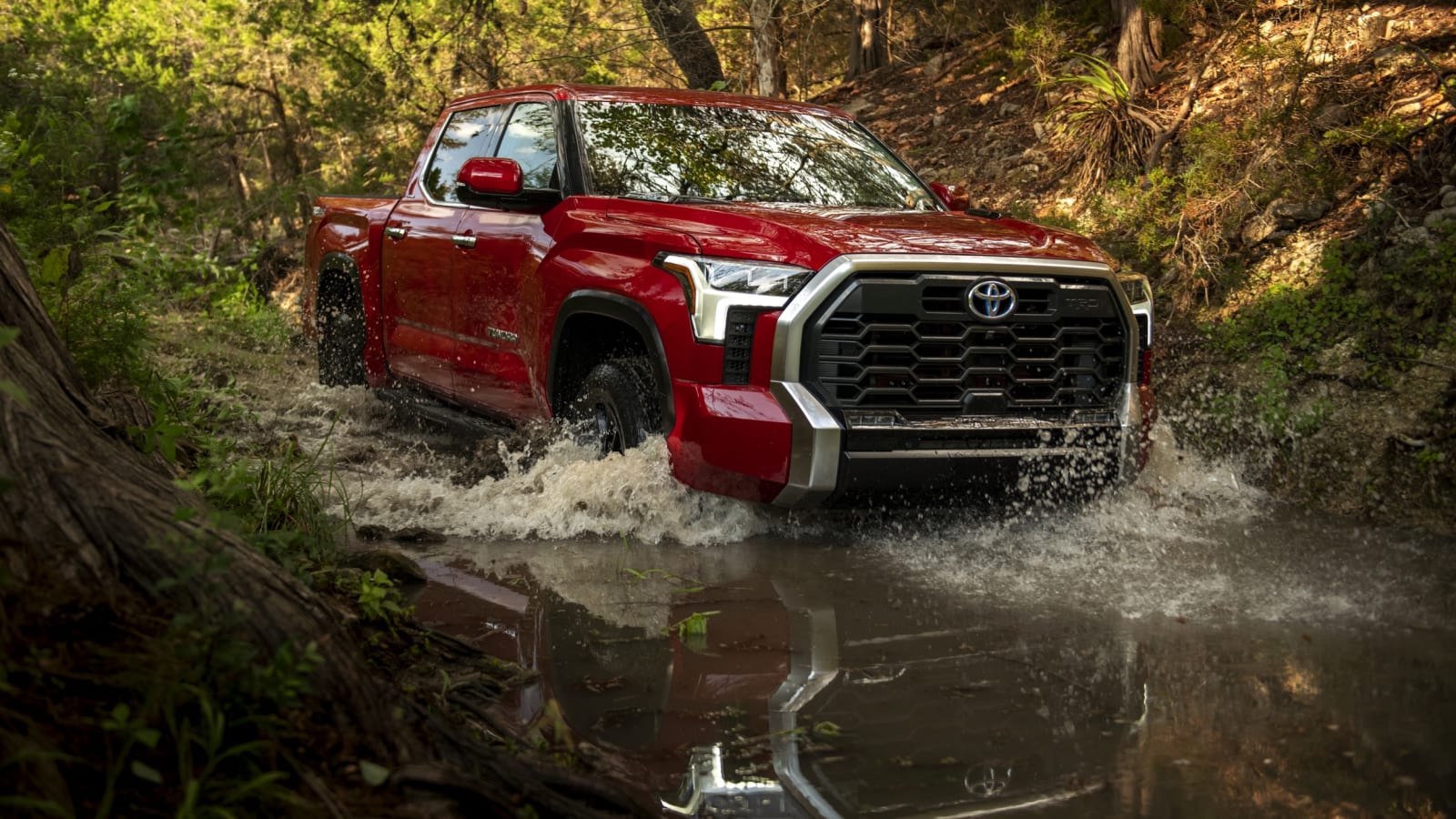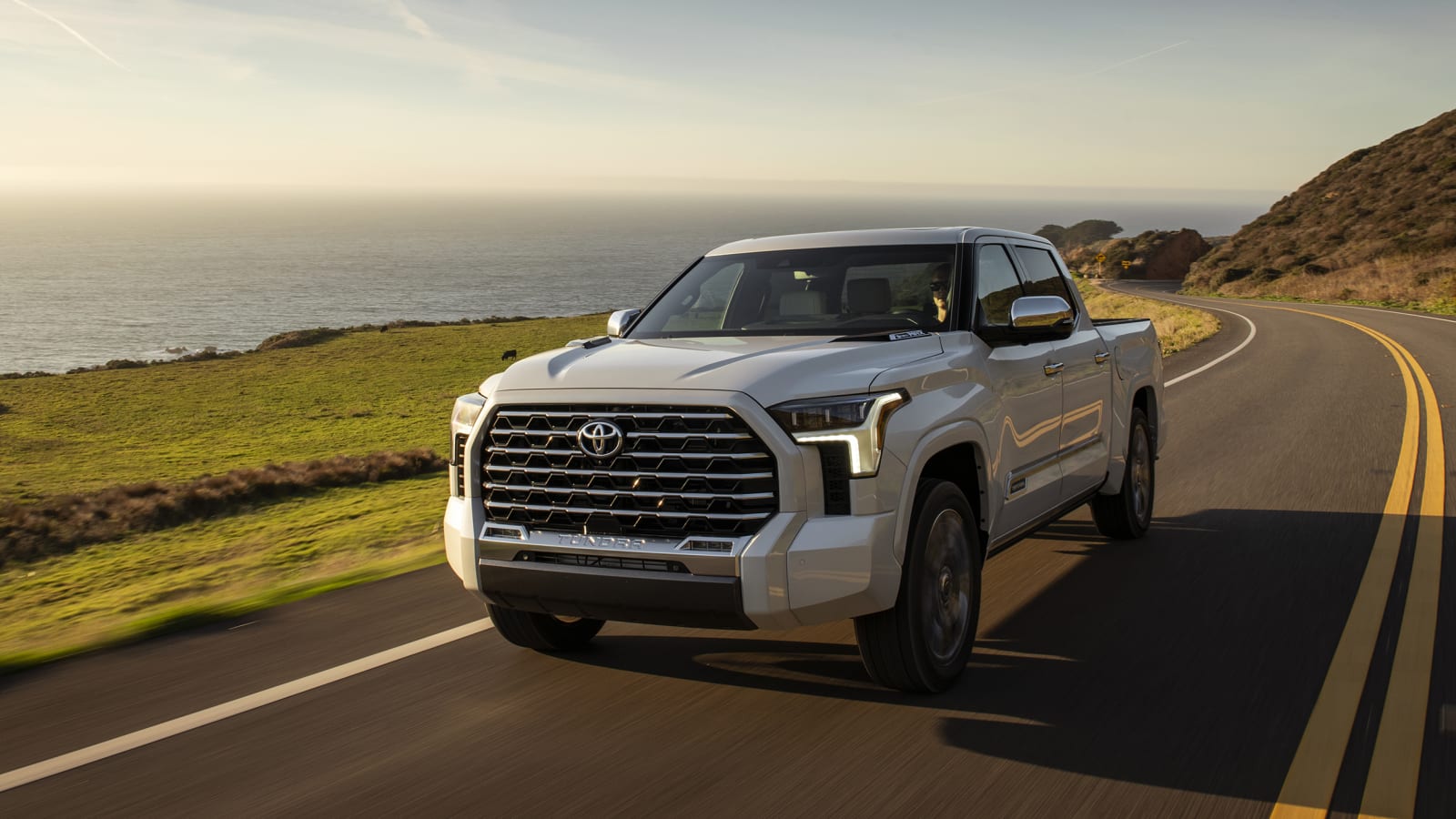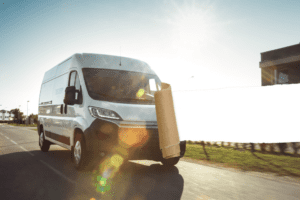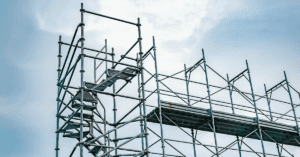2022 Toyota Tundra Review | A real competitor once again

The 2022 Toyota Tundra is totally new this year and ready to take on other pickups in the hyper-competitive world that is the fullsize truck market. It brings a new twin-turbo V6 powertrain along with it, but an available hybrid drive system is the shining star of the show with more power than any other truck (minus the Ram TRX, of course). Toyota also switches to a coil spring rear suspension setup for greater comfort and stability.
Step inside, and both the interior amenities and in-cabin tech are competitive with the best available. Toyota has even joined the mega-luxury truck world with its top-of-the-line Capstone trim that brings a near-Lexus-like interior ambiance with rich materials and eye-catching trim. And for the off-roading enthusiast, the TRD Pro is back as Toyota’s maximum attack for off-road performance, and it comes with all the goodies you’d expect: Fox internal bypass shocks, all-terrain tires, greater ground clearance and a vastly different exterior look to set it apart.
Unfortunately, while the new Tundra does a lot of things well, it does not trounce the competition in any one area. It is not class-leading in towing or payload capacity. The hybrid doesn’t get better fuel economy than Ford’s PowerBoost hybrid. And it doesn’t feature any high-tech hands-free driver assistance features like the F-150 and GMC Sierra 1500 will soon boast. Being a Toyota truck, one can assume it will hold its value better than most in the long-term and score well in reliability ratings. However, for now, it’s simply an excellent full-size pickup that competes well against others, but fails to pull away from the pack in any significant way.
Interior & Technology | Passenger & Cargo Space | Performance & Fuel Economy
What it’s like to drive | Pricing & Features | Crash Ratings & Safety Features
What’s new for 2022?
The 2022 Toyota Tundra is completely redesigned for the 2022 model year.


What are the Tundra’s interior and in-car technology like?
The new dash is logically laid out, with all the necessary buttons, switches and knobs within easy reach of the driver. There are storage compartments and nooks to stick your belongings throughout the interior, plus an available wireless phone charger. Depending on trim, the Tundra offers a bunch of interior surfaces and trimmings. Base SR and SR5 trucks get fabric that feels pretty durable; the Limited trim gains SofTex imitation leather and power adjustability for the seats. The Platinum and 1794 editions get leather with some cool perforation patterns and colorful highlights, while the Capstone (above, bottom right) travels even deeper into the luxury realm to meet the challenge posed by the ultra-lux Ford F-150 Limited and GMC Sierra Denali Ultimate. Plus, there’s the TRD Pro (above, bottom left) that goes with a digital camouflage upholstery pattern.
Toyota’s latest Audio Multimedia infotainment system is the star of the interior, displayed on either an 8-inch touchscreen or much more desirable 14-inch touchscreen, both with wireless Apple CarPlay and Android Auto capability. It’s a totally new generation of infotainment for Toyota, completely unrecognizable from the old, and it’s lightyears better. Responsiveness is top-notch, and the menu layout is simple and easy to navigate with an appealing user interface design. We do think Toyota is relying too much on the system’s new voice control functionality (we have doubts that owners will prefer talking to their trucks) and dislike the lack of home screen or split screen views. Only one function can be displayed at a time, which can seem like a waste of 14-inch touchscreen real estate.
How big is the Tundra?
Two cab configurations and three bed sizes are available for the Tundra, but not all of them are available on each trim. For example, the SR5 is the most flexible model. You can have it in the base Double Cab with either the medium 6.5-foot or long 8.1-foot bed. You can also have it in the larger CrewMax cab with the short 5.5-foot or medium 6.5-foot bed. There are no two-door standard cab configurations available, so it’s four-doors or nothing. A single five-passenger capacity is standard on every model, and there is no six-passenger option.
You’ll want the CrewMax if you want to maximize rear comfort, as that model has 41.6 inches of legroom versus the Double Cab’s 33.3 inches. There’s very little reason to compare the rear seats of fullsize pickups, as they’re all similarly enormous (crew cabs) or cramped (extended cabs). That’s the case here with the Tundra.




What are the Tundra’s fuel economy and performance specs?
There are three powertrain options available for the Tundra, all stemming from the same basic 3.5-liter twin-turbo V6 powerplant. It’s technically a 3.4-liter but Toyota chooses to round up, probably for marketing purposes, so we’re using that number to avoid confusion by being consistent.
The base SR is the only trim that comes with a de-tuned twin-turbo V6 that makes 348 horsepower and 405 pound-feet of torque. It’s paired to a 10-speed automatic transmission that is shared across the entire Tundra lineup. Fuel economy for this model is rated at 18 mpg city, 24 mpg highway and 20 mpg combined when paired with rear-wheel drive. Opting for four-wheel drive brings those figures down to 17/23/19 mpg.
The rest of the trim levels, save for the tippy-top Capstone, come with the standard version of the twin-turbo V6. In this guise, it makes 389 horsepower and 479 pound-feet of torque. Fuel economy drops by 1 mpg on the highway versus the de-tuned version of this engine, so it’s rated at 18/23/20 mpg with rear-wheel drive. Stepping up to four-wheel drive brings these figures down to 17/22/19 mpg, except for the SR5 trim level that earns 23 mpg on the highway.
The most potent powertrain available is the i-Force Max hybrid that combines the same twin-turbo V6 with an electric motor for even more power. Combined output is a stout 437 horsepower and 583 pound-feet of torque, beating out even the F-150 PowerBoost. Fuel economy is not listed on the EPA’s site yet, but Toyota says the hybrid achieves 20 mpg city, 24 mpg highway and 22 mpg combined with rear-wheel drive. Opt for four-wheel drive, and those figures drop to 19/22/21 mpg. Get the TRD Pro, and highway fuel economy drops again by 1 mpg down to 21.
What’s the Tundra like to drive?
The Tundra is now the second full-size pickup to join the rear coil spring club, next to the Ram 1500, and it’s better to drive for it, with an improved ride and better stability, especially while towing. If you want maximum comfort and the most car-oriented drive characteristics, you’ll want the top-of-the-line Adaptive Variable Suspension option that adjusts the truck’s damping on the fly to smooth out bumps. That said, most will get a Tundra with the standard coils and twin-tube passive shocks, and it’s perfectly respectable with a firm but not harsh ride. Large bumps are handled well too, without jarring shocks or the side-stepping feel that leaf springs sometimes exhibit. Air springs are available on either setup, and they work to keep the rear end level regardless of what you’re carrying or hauling.
The TRD Off-Road package adds Bilstein shocks for better performance off-road, though we didn’t notice much difference in ride and handling on pavement. However, we think the package handles high-speed ruts and ridges with a bit more body control than the base setup. Go all the way up to the TRD Pro, and you get the epic 2.5-inch diameter Fox internal bypass shocks with piggyback reservoirs. Our brief experience with the TRD Pro told us that it’s bit more rough-and-tumble on the road versus the standard suspension.
As for the powertrain, the twin-turbo V6 and 10-speed automatic are a smooth pair — the transmission largely falls into the background when just moseying around town with buttery shifts. Wait just a moment for the boost to build, and there’s no missing the old, outgoing V8. Power comes on stronger with revs, and this truck is plenty quick for any daily driving duty. Very little noise reaches the driver via the engine or exhaust, but a faux soundtrack is piped into the cabin that makes the Tundra’s V6 sound much burlier than it is. We had some misgivings with the transmission’s responsiveness in our first drive, but didn’t experience the same hesitations in a week-long loan thereafter. Perhaps Toyota smoothed things out in the interim?
The i-Force Max hybrid is decidedly stronger. In particular, it provides an instant thrust at city street and highway speeds that you can feel from the seat of the pants. Plus, you get better fuel economy. We wish the fuel economy gains were even greater, but even small relatively small mpg gains will greatly help in running costs over time.
What other Toyota Tundra reviews can I read?
2022 Toyota Tundra First Drive Review
Our in-depth look at the new Tundra, including its many changes, new design and engineering advancements.

2022 Toyota Tundra Capstone First Drive
Diving deeper into the new range-topping Capstone trim, which is Toyota’s answer to Ford and GMC’s ultra-luxury pickups.

2022 Toyota Tundra i-Force Max vs 2022 Ford F-150 PowerBoost Hybrid Spec Comparison
Taking a close look at the specs for the new hybrid Tundra versus Ford’s hybrid F-150.

How much is the 2022 Tundra’s price and what features are available?
The 2022 Toyota Tundra starts at $37,645 for the SR Double Cab with a 6.5-foot bed and rear-wheel drive. This truck comes with 18-inch steel wheels, LED headlights and taillights, heated side mirrors, keyless entry, fabric seats, single-zone auto climate control, power rear window, 8-inch touchscreen infotainment with Apple CarPlay and Android Auto, and a six-speaker audio system.
From that basic standard above, you can go wild with different trim levels, packages and accessories. To call out some popular configurations, the SR5 with its standard (not de-tuned) version of the twin-turbo V6 starts at $42,450. Adding four-wheel drive to any trim adds $3,000 to the MSRP. And if you want the hybrid, the entry point here is a Limited CrewMax at $53,995. For the top-of-the-line Capstone (below right), you’ll need to shell out $75,225. The TRD Pro (below left) starts at $68,500.
To give you a starting point for your shopping, we’ve listed out all of the trims and their starting prices below, including the $1,695 destination charge. Do note that the cab, bed and drive choice will change these prices, all in the upward direction. For a breakdown of features, specs and local pricing for each 2022 Tundra variant, look here on Autoblog for non-hybrid trims and here for hybrid trims (yeah, two places, we admit it’s annoying. Sorry).
SR: $37,645
SR5: $42,450
Limited: $48,545
Platinum: $59,015
1794: $59,385
TRD Pro: $68,500
Capstone: $75,225


What are the Tundra’s safety ratings and driver assistance features?
The Tundra comes with a number of driver assistance features as standard equipment. These include everything in the Toyota Safety Sense 2.5 suite: Forward automatic emergency braking with pedestrian detection, adaptive cruise control with lane-centering steering assist, lane departure warning and lane-keeping assist, auto high beams and traffic sign assist. A few systems are optional, and those include blind-spot and rear cross-traffic warning, front and rear parking sensors, and rear automatic emergency braking.
Neither NHTSA nor the Insurance Institute for Highway Safety had tested the Tundra at the time of this writing.
Related Video:






